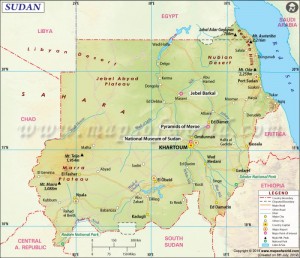26-Day Cairo to Khartoum: Day 19-22: Wadi Halfa, Kerma & Karima
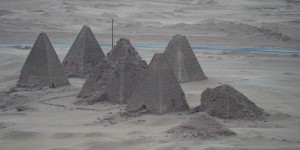 |
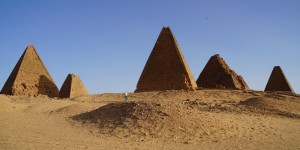 |
After having spent 18 days in Egypt, we crossed the border into Sudan (also known as North Sudan). Labelled as a state sponsor of terrorism and being subject to sanction by the US, Sudan is not a destination for the faint-hearted tourists. But the country, home to many ancient civilisations and land of contrast, is amazing. I have seen more pyramids in Sudan than in Egypt.
Sudan (or known as North Sudan) is the third largest country in Africa after Algeria and Congo with an area of 1,886,068km² and a population of 37 million. It was the largest country in Africa and the Arab world until 2011 when South Sudan became independent. Sudan has a long and complicated history. Several important periods are highlighted below-
- Pre-historic period (before c. 21st century BC)Evidence shows that people already settled into a sedentary life along the Nile by 8,000 BC. During the pre-dynastic periods, Nubia and Nagadan Upper Egypt, were identical and both evolved systems of pharaonic kingship by 3300 BC. (According to a legend, Horus, the falcon-headed god and protector of the pharaoh, lost an eye in the battle with his brother Seth, a fight that was said to have taken place in Nubia.)For more than two thousand years, the Old Kingdom of Egypt (c.2700-2180 BC), had a dominating and significant influence in the region. Powerful native kingdoms began to emerge in the first millennium.
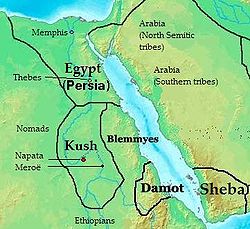 Kingdom of Kush (1070 BC – 350 AD) A number of large Nubian / native kingdoms emerged throughout the Post classical Era (the period of time that immediately followed the ancient history and preceded the modern history). The kingdom of Kush centering on the confluences of the Blue Nile and White Nile and the Atbarah River and the Nile River, rose to power as the New Kingdom of Egypt disintegrated. The Kushite King Kashta who ruled from Napata, conquered Upper Egypt around 750 BC and became ruler of Thebes until approximately 740 BC. His successor, Piye extended his power to include Nile Delta thus initiating the 25th Dynasty of Egypt (the Nubian Dynasty). His son Taharqa reunited the ‘Two Lands” of Northern and Southern Egypt and created an empire stretching from what is now known as South Kordofan all the way to Sinai. This dynasty ushered in a renaissance period for Ancient Egypt: Nubian pharaohs built or restored temples and monuments throughout the Nile valley. They also constructed pyramids, many of which were located in Sudan. The Nubian dynasty in Egypt ended when driven out by the Assyrians around 671 BC. The Kushite court continued to rule in Nubia. Around 590 BC, an Egyptian army sacked Napata, compelling the court to move to a more secure location at Meroë near the Sixth Cataract. The Meroitic Kingdom of Kush gradually developed independently of Egyptian influence and domination. The civilisation of Kush was among the first in the world to use iron smelting technology. The Nubian kingdom at Meroe persisted till the fourth century AD.
Kingdom of Kush (1070 BC – 350 AD) A number of large Nubian / native kingdoms emerged throughout the Post classical Era (the period of time that immediately followed the ancient history and preceded the modern history). The kingdom of Kush centering on the confluences of the Blue Nile and White Nile and the Atbarah River and the Nile River, rose to power as the New Kingdom of Egypt disintegrated. The Kushite King Kashta who ruled from Napata, conquered Upper Egypt around 750 BC and became ruler of Thebes until approximately 740 BC. His successor, Piye extended his power to include Nile Delta thus initiating the 25th Dynasty of Egypt (the Nubian Dynasty). His son Taharqa reunited the ‘Two Lands” of Northern and Southern Egypt and created an empire stretching from what is now known as South Kordofan all the way to Sinai. This dynasty ushered in a renaissance period for Ancient Egypt: Nubian pharaohs built or restored temples and monuments throughout the Nile valley. They also constructed pyramids, many of which were located in Sudan. The Nubian dynasty in Egypt ended when driven out by the Assyrians around 671 BC. The Kushite court continued to rule in Nubia. Around 590 BC, an Egyptian army sacked Napata, compelling the court to move to a more secure location at Meroë near the Sixth Cataract. The Meroitic Kingdom of Kush gradually developed independently of Egyptian influence and domination. The civilisation of Kush was among the first in the world to use iron smelting technology. The Nubian kingdom at Meroe persisted till the fourth century AD.- Christian Nubia – By the sixth century AD, three states/kingdoms had emerged namely Nobatia in the north with its capital at Faras, Muqurra centred at Old Dongola, and Alodia occupying the heartland of old Meroëwith capital at Soba (modern-day Khartoum). A missionary arrived in Nobatia to preach Christianity in the region about AD 540. The Christian Nubian kingdoms achieved their peak of prosperity and military power in the 9th and 10th centuries AD before a gradual decline.
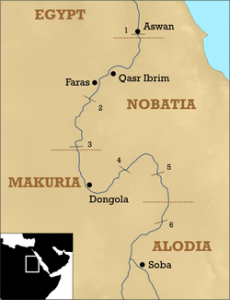
- Islamisation – Islam reached Egypt in the seventh century AD and spread through religious conversion as a result of military conquests and trade relations. Sudan is an Islamic country: 97% of the population is Muslim.
- Sennar Dynasty(1505 – 1821) In the 15th century, the area came under the control of Abdallah Jamma, a Muslim from the eastern region. A century later, the Funj people under Amara Dunqas arrived from the south and defeated Abdallah to set up their own kingdom based at Sennar. In 1523, the Sennar monarchy officially converted to Islam. The dynasty lasted till 1821 with some 30 monarchs.
- Ali Dynasty (1821 to 1885) – In 1821, Ismail bin Muhammad Ali led an army into Sennar and absorbed the realm into the “Ottoman Egypt”.
- The Mahdiyah(1885-1889) – In 1881, Muhammad Ahmad, a religious leader, proclaimed himself the Mahdi (“guided one”) and began a war to unify the tribes in western and central Sudan. His followers took the name ‘Ansars” (“followers”) in association with the Umma Party. Mahdi led a nationalist revolt culminating in the fall of Khartoum on January 26, 1885. The interim governor-general of Sudan, the British Major-General Charles George Gordon, and many of the 50,000 inhabitants of Khartoum were massacred. Mahdi died in June 1885 and was succeeded by Abdallahi ibn Muhammad, known as the Khalifa, who began intruding into Ethiopia. Following his victories in eastern Ethiopia, he sent an army to invade Egypt where it was defeated by the British at Toshky.
- Anglo-Egyptian Sudan (1899-1956) –An Anglo-Egyptian force under Lord Kitchener was sent to Sudan in 1898 and proclaimed the region a condominium the following year putting Sudan under British-Egyptian administration. Nonetheless the British was the defacto ruler formulating policies and supplied most of the top administrators.
- Independent Sudan 1956 to present –The region had been under the shadow of and intertwined relationship with the Egyptians for millennium. Sudanese were finally given a chance for a free vote on whether they wished independence or a British withdrawal. This came after Egypt abandoned its claim of sovereignty over Sudan and both Britain and Egypt sensing a great instability in the region were ready to opt out.However, the country hassince been plagued by protracted social and internal conflict including the First Civil War (1955-1972), the Second Civil War (1983-2005), culminating in the secession of South Sudan on July 9, 2011 and the War in Darfur (2003-2010). It also has had a troubled relationship with many of its neighbours and many western countries owing to its radical Islamic stance. US has listed it as a state sponsor of terrorism and imposed economic sanction.
Sudan is a diverse country with some 600 ethnic groups which speak over 400 different languages and dialects. The majority of the population (70%) is Sudanese Arab. Other main groups include Nubians, Zaghawa and Copts. Its culture combines Nubian and Arabic elements. The majority of the population (97%) is Muslim.
Economicdevelopmenthas been restrained by corruption, poor governance, international sanction and ongoing conflicts in Southern Kordofan, Darfur, and the Blue Nile states, lack of infrastructure in large areas and reliance of subsistence agriculture. It lost three-quarters of its oil production following the session of South Sudan and has to struggle to stablise its economy. The GDP (nominal) (2016 est) and GDP (PPP) (2014 est) is $84.33 billion and $179.5 billion respectively (i.e. $4,500 per capita (nominal) and $4,834 PPP). Almost one-fifth of the populationis living below the international poverty line (ie living on less than US$1.25 per day).
Day 19 November 9 Wednesday: Abul Simbel, Egypt – Wadi Halfa, Sudan
After spending two hours at the Egyptian border, we were finally able to enter Sudan. But it took us a long time to clear both the immigration and customs authorities. We were first met by Ayat, our guide who told us how to fill in the form. He had to fill in certain information in Arabic for us too. Unlike the poor facilities on the Egyptian side, the Sudanese provides a decent waiting room with seats and good ventilation. Three counters were opened and the officers processed our papers quickly. All of us had no problem except one of the members who had her visa on a page attached to her passport by herself. (She had taken an old page from her old passport and attached it to the new one. Apparently she had asked the consulate staff in Aswan to put the visa on that particular page. She did so because she did not want to leave any trace of her visit to Sudan in her passport. As such, she could continue to enter the USA without visa under the ETA scheme.) It’s the first time I have ever seen someone doing such a foolish thing! Had the Sudanese immigration authority followed the book, she could be refused entry without a valid visa on her passport. Anyway, our guide must have begged the officials to let her in: she finally got her passport stamped.
Next, we changed our Egyptian pounds and US dollars into Sudanese pounds (SDG). The official rate was about 1 USD for 6.5 SDG. But we got about 10 SDG for a dollar. I suppose the black market rate would be much higher. Afterward, we had to wait for Xara, our truck to be cleared by the customs authority. We did not leave the border control till 2:45pm.
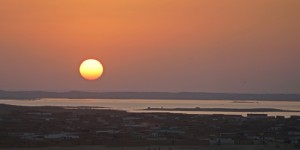 We spent our first night in a small local guesthouse in Wadi Halfa, a small border town. I shared a room with a fan with Barbara and Alexis. The place is tidy by local standards with toilets and showers in the backyard. Before joining Alexis for an early dinner, I climbed up a hill behind the town to watch sunset.
We spent our first night in a small local guesthouse in Wadi Halfa, a small border town. I shared a room with a fan with Barbara and Alexis. The place is tidy by local standards with toilets and showers in the backyard. Before joining Alexis for an early dinner, I climbed up a hill behind the town to watch sunset.
Alexis and I shared a grilled chicken with rice (30 SDG each). Later I ran into Isa and Natascha, two independent German travel writers who would spend two weeks by taking public transportation to Khartoum. One of them speaks Japanese and has completed the 88-temple pilgrimage journey of over 1,000km in Shikoku, Japan. I am most impressed.
I was ready for bed. Unfortunately the power was soon cut when a vehicle ran into the power line supplying electricity in the vicinity around 8:30pm. As a result, we had no fan for the next two hours. The ferocious mosquitoes forced me to retreat to my sleeping bag despite the heat. When I could stand the heat no more, I got out and fell prey to the mosquitoes! Thank God, electricity was back after 10:30pm. The room cooled down surprisingly quickly and I finally managed to sleep.
Day 20 November 10 Thursday: Wadi Halfa- Wawa
We went to a local eatery for breakfast. I had tea and fou (beans) with bread (13 SDG). We would be spending four out of five nights camping on our way to Khartoum, the first two cook groups had to shop in a local market. As Jason, Mat and I were in the third cook group, I had free time. Anyway, I went to the market and found it surprisingly clean and tidy with plenty of fresh fruits, vegetables and meat. The locals look honest and properly dressed: no sign of destitute.
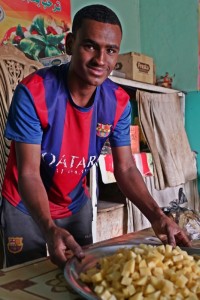 |
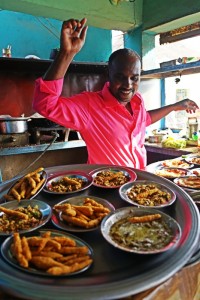 |
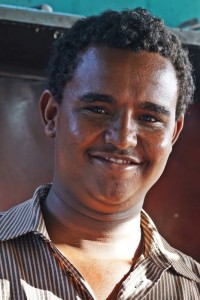 |
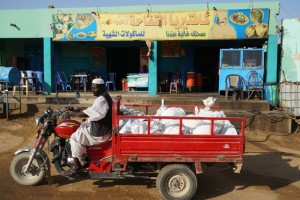 We set off after 10:30am driving through the Nubian desert. The heat was more intense. After picking up our a local guide, we drove a short distance to a village where we were met by its chief. We followed our local guide walking towards the river bank. Then we crossed the Nile in a small boat in two groups. After a few minutes’ walk, a magnificent ruin came into view: the Temple of Solebdedicated to Amun Re.
We set off after 10:30am driving through the Nubian desert. The heat was more intense. After picking up our a local guide, we drove a short distance to a village where we were met by its chief. We followed our local guide walking towards the river bank. Then we crossed the Nile in a small boat in two groups. After a few minutes’ walk, a magnificent ruin came into view: the Temple of Solebdedicated to Amun Re.
In those days, the pharaohs could be reached by boat.Soleb is an ancient Nubian town and the location of a vast necropolis with small tomb chapels decorated with pyramids. The earliest royal toms date to the 18th dynasty. Located north of the third cataract of the Nile, this temple about 130m in lengthis the southern-most temple built by the Egyptian pharaoh Amenhotep III. The ruin was discovered by Richard Lepsius in 1844.
There is a processional way leading from the river to the temple which may be. We saw scattered blocks of two pylons, a hypostyle hall, a court and a sanctuary: its layout is similar to those at the Temple of Luxor. The relief carvings show the sed festival of Amenhotep (it was a celebration of renewal, first enacted in the 30th year of a pharaoh’s rule and then every three years thereafter. It was the most important ritual in a pharaoh’s reign). We saw representations of the solar eye (the ruling god Amun) and the lunar eye (a lioness goddess Tefnutmmehit). Two red granite lion statutes from this temple had been moved in antiquity to the Temple of Amun at Jebel Barkal before being taken to the British Museum.
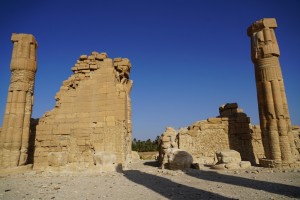 |
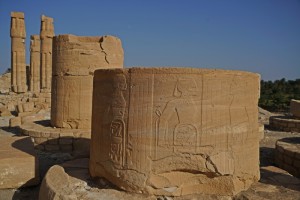 |
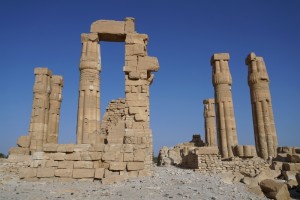 |
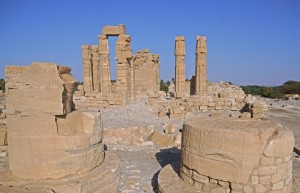 |
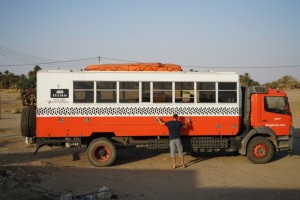 The village chief kindly gave us permission to camp close to his house off the main road. He let us use water from the tap, the toilet and shower. Maddy was my tent-mate and we both have travelled with Dragoman before. I had no problem settling in the camping routine and enjoyed a nice shower before dinner.
The village chief kindly gave us permission to camp close to his house off the main road. He let us use water from the tap, the toilet and shower. Maddy was my tent-mate and we both have travelled with Dragoman before. I had no problem settling in the camping routine and enjoyed a nice shower before dinner.
The first cook group prepared a healthy and delicious with vegetables and pasta. As I had not brought a ground mattress with me, I found the ground too hard. I tossed around the whole night and hardly had any sleep. I was a nuisance and worried I kept Maddy awake. I was also bitten by bugs. Not a good start!
Day 21 November 11 Friday: Wawa – Kerma
I like the Sudanese who have been nice and welcoming. The village chief arranged us to have a village tour before departure. This Nubian village has 850 inhabitants and all the houses are white-washed , often decorated with painting on the walls and doors. The paintings are simple and rustic with artistic designs by women. We visited a bakery. Then a man who works in Saudi Arabia and has six children, invited us to visit his house which is big with 6-8 rooms spreading over two buildings. His beautiful young wife was breast-feeding their youngest child.
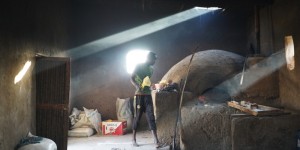 |
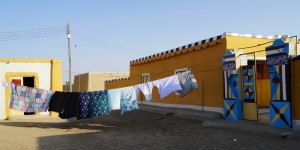 |
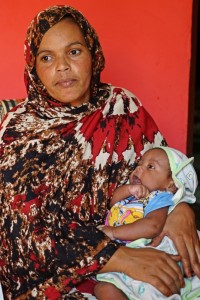 |
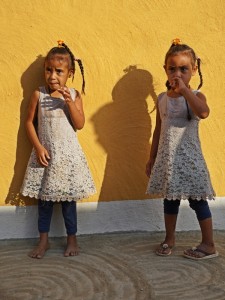 |
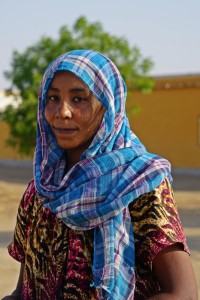 |
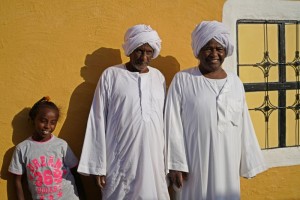 |
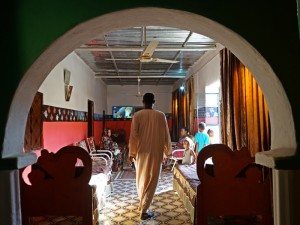 |
Our first stop today was the Third Cataract, a popular lookout point with fantastic views of the Nile and surrounding areas.
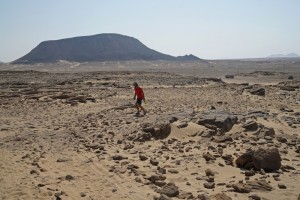 |
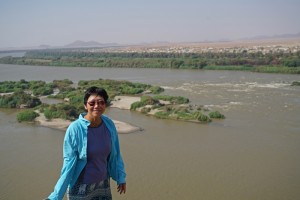 |
Next we went to Wadi Sebu (dried river) nearby to see rock paintings some of which are 8,000-10,000 years old. There are plenty of drawings of animals including elephant, giraffe, cow and deer. Occasionally, a few small human figures appeared. On one rock, I saw a number of boats. It was scorching hot to walk in the dry river bed for over half an hour. Luckily I survived without sunstroke.
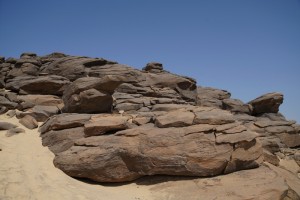 |
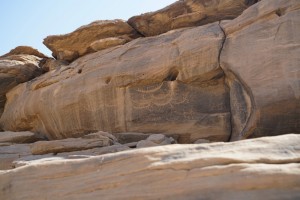 |
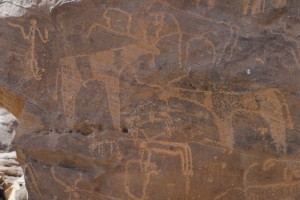 |
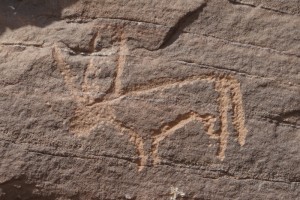 |
I had panfried fresh catfish for 25 SDG in a roadside eatery. Delicious! Our final stop was at Kerma, the capital of the first independent kingdom of Kush which heyday was from 1750 to 1600BC. Evidence of early culture can be traced in Kerma around 2400BC. By 1700 BC, it had a population of at least 10,000 people.
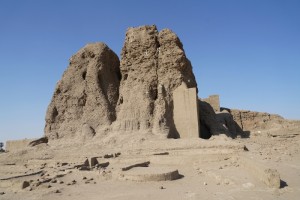 |
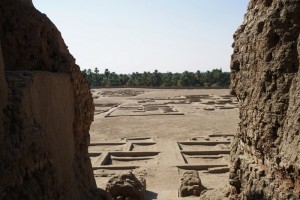 |
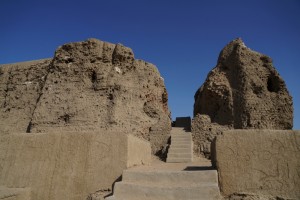 |
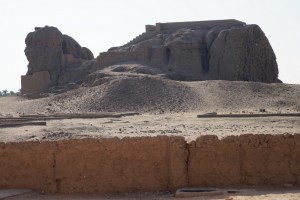 |
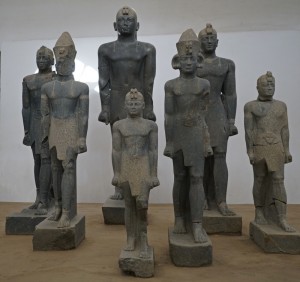 Ayat took us to see the Royal Town of Kerma and the Deffufa Temple (a mud-brick building) of over 3,500 years old (possibly the oldest man-made structure in sub-Sahara Africa). The ruin measuring 50m by 25m and standing over 18m tall is ancient and weather-beaten with a majestic and mysterious appearance. We had fabulous 360º view of the royal town which was resided by the royal families and priests as well as the expansive rich agricultural land next to the Nile.
Ayat took us to see the Royal Town of Kerma and the Deffufa Temple (a mud-brick building) of over 3,500 years old (possibly the oldest man-made structure in sub-Sahara Africa). The ruin measuring 50m by 25m and standing over 18m tall is ancient and weather-beaten with a majestic and mysterious appearance. We had fabulous 360º view of the royal town which was resided by the royal families and priests as well as the expansive rich agricultural land next to the Nile.
Afterward, we went to the museum which has some interesting exhibits including seven statutes of pharaohs of the Nubian 25th Dynasty of Egypt, pottery, agricultural tools etc unearthed in the area. The illustrations are in English and Ayat has provided me with additional information. I am therefore better appreciate the achievements of this ancient civilisation.
We met a group of ladies outside the museum. One is particularly striking: her features reminds me of beautiful women of Ethiopia. She insisted in treating Stewart with sweets. Why Stewart? We teased him and urged him to find a Nubian wife!
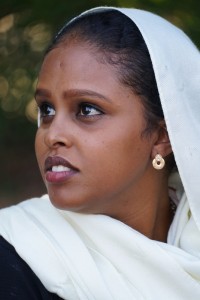 |
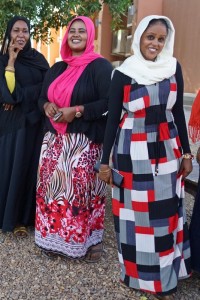 |
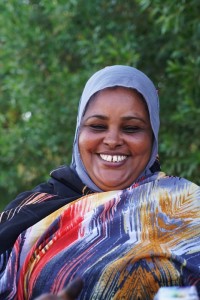 |
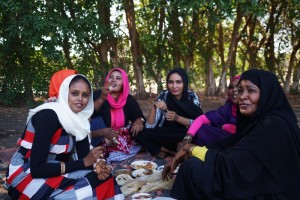 |
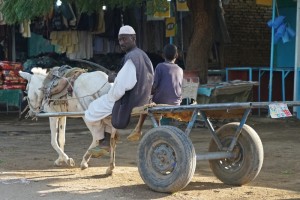 |
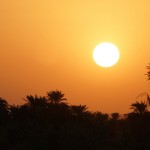 We stopped briefly in the town of Kerma to get a few last minute things for dinner. Then we drove a short distance before finding a suitable flat field as a camp ground. The friendly land owner let us camp and his wife came to watch us setting up our tents. I asked her through Ayat whether I could take a shower in her house and would pay. She gave me a full bucket of water for a nice warm shower. When she refused to take money, I gave her a pack of digestive biscuit for her children as a token of appreciation. In return, she invited me to tea.
We stopped briefly in the town of Kerma to get a few last minute things for dinner. Then we drove a short distance before finding a suitable flat field as a camp ground. The friendly land owner let us camp and his wife came to watch us setting up our tents. I asked her through Ayat whether I could take a shower in her house and would pay. She gave me a full bucket of water for a nice warm shower. When she refused to take money, I gave her a pack of digestive biscuit for her children as a token of appreciation. In return, she invited me to tea.
I always enjoy spending time with the locals and their home. Her house with three rooms and a garden is tidy. The rooms are bare and without light (I do not know whether they have electricity). When I arrived, she moved a bed to the courtyard as it was still hot inside. The moon shone brightly over us and we enjoyed a pleasant breeze. Though we could not talk, we communicated through sign language. I find out that she is 35 years old with four children. Tonight I slept with a mattress lent to me by Stewart: he is caring and considerate. He gave me his inflatable mattress and slept on his blanket. I was moved by his kindness. I slept better but I had a few more bites that evening.
Day 22 November 12 Saturday: Kerma – Karima
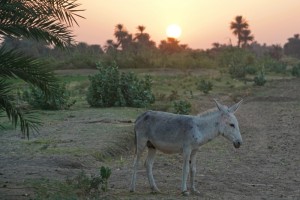 |
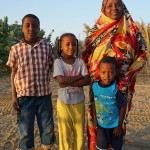 |
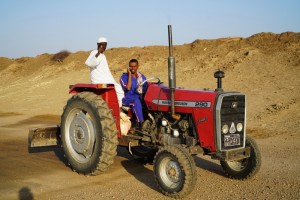 |
We had an early start and had a shopping stop at Selim, a small town right by the Nile at 9:15am. Jason, Mat and I who were responsible to prepare dinner that evening, had to shop in the local market. We agreed on a simple menu: noodles and stir-fry vegetables and roast chicken if we could get one. But we found few types of vegetables in the market. Anyway, we bought 12 packs of instant noodles, some aubergines, onions and a kilo of green pepper. We also brought 30 eggs, a kilo of oranges and bananas and three tins of pineapples for breakfast. But we could not find quality meat. Ayat suggested we shop at the lunch stop. While we were back in the truck before 10am as instructed, we had to wait for others till 10:30am.
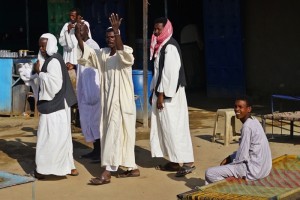 |
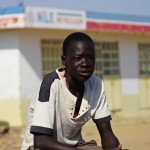 |
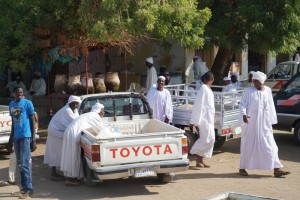 |
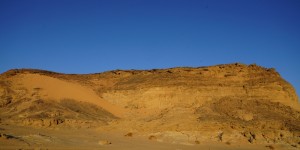 By 1 pm, we arrived in the Nubian House a simple guesthouse before 1pm. I went to the town and had half a chicken for lunch (33 SDG). The supermarkets are better stocked and we got cereal, lentil and sausages. We did not set off for sight-seeing till 4pm when it was not deadly hot. We spent the afternoon washing dirty clothes which could be dry in less than an hour under the sun.
By 1 pm, we arrived in the Nubian House a simple guesthouse before 1pm. I went to the town and had half a chicken for lunch (33 SDG). The supermarkets are better stocked and we got cereal, lentil and sausages. We did not set off for sight-seeing till 4pm when it was not deadly hot. We spent the afternoon washing dirty clothes which could be dry in less than an hour under the sun.
At 4pm, we assembled and followed Ayat to walk ten minutes to the foot of Jebel Barkal, the holy mountain (an enormous sandstone butte with a free-standing pinnacle) that dominates this stretch of the Nile. The ancient Egyptians and Nubians believed that this mountain was the home of the god Amun, the ‘Throne of Two Lands’- Egypt and Nubia. So a temple dedicated to Amun was built at the foot of Jebel Barkal and Thutmose III, one of the first Egyptian kings to penetrate this far south, built the first Temple of Amun in the 15th century BC. It was expanded by subsequent pharaohs including Rameses II. When the subsequent waning of Egyptian influence and rise of the Kushites, Jebel Barkal became the centre of the new kingdom of Kush which also gave the Nubian kings legitimacy to their claim to be the true representative of Egyptian traditions. Nubian kings set up the 25th Dynasty and ruled from Thebes and Memphis as pharaohs. The temple is very ruined and much of the structure is covered with sand. There are two large colonnade halls leading into the sanctuary at the base of the mountain.
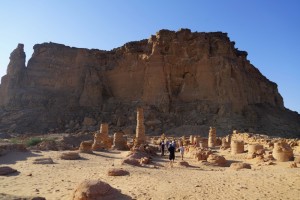 |
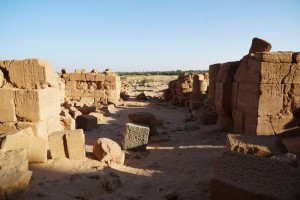 |
The Temple of Mut built by Taharqa and dedicated to the sky god and wife of Amun is much ruined. The most prominent features here are two large columns with capitals carved with the image of the goddess Hathor. We were able to visit the sanctuary of the temple which was carved into the mountain with colour paintings that are still visible. There are carvings of Bes, a protector of women in childbirth in this temple. One explanation is that royal wives possibly came here during pregnancy to signify the divine origins of their lineage. The air was so stuffy that I had to rush out for fresh air.
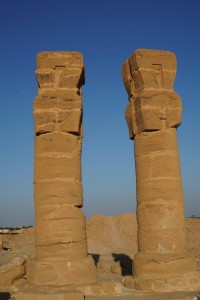 |
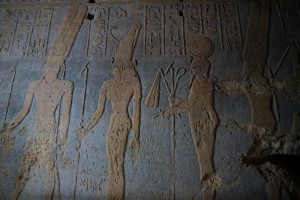 |
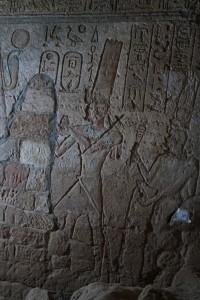 |
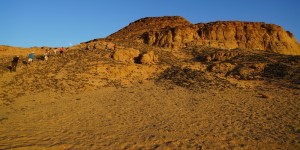 Ayat suggested us watch sunset from the flat top of Jebel Barkal. The ascent took less that 30 minutes. Rinske had an accident and hurt her ankle: she had to limp around for the next few days. The views from the top are awesome. I could see the Temple of Amun and Mut and other palaces ruins below, the Nile in a distance and lush green plains in all directions. I could also vaguely see the silhouette of the pyramids at Nuri. We watched the sunset in total silence, overwhelmed by the indescribable beautify and the sense of eternity.
Ayat suggested us watch sunset from the flat top of Jebel Barkal. The ascent took less that 30 minutes. Rinske had an accident and hurt her ankle: she had to limp around for the next few days. The views from the top are awesome. I could see the Temple of Amun and Mut and other palaces ruins below, the Nile in a distance and lush green plains in all directions. I could also vaguely see the silhouette of the pyramids at Nuri. We watched the sunset in total silence, overwhelmed by the indescribable beautify and the sense of eternity.
We took the quickest downhill route by rushing through the soft sand and arriving at the bottom in five minutes. It’s fun! We were back in the Nubian House around 7pm.
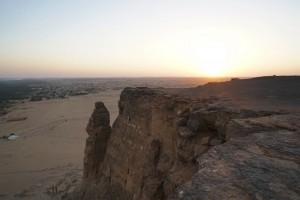 |
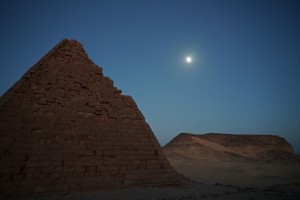 |
My cook group got into action. We cooked in the kitchen and served the food in the courtyard. This arrangement in a way created extra work. I think our group is the worst cook group. Our friends had been very polite to us and tried to finish the food laid on the table. I shared a room with Rinske and Alexis. It was so hot that I woke up twice and had to go out for fresh air. I might have slept less than four hours (anyway I had more sleep than in the tent).


